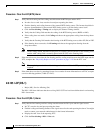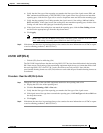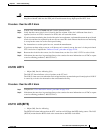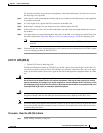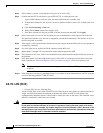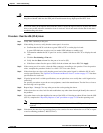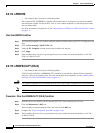
2-81
Cisco ONS 15327 Troubleshooting Guide, R3.4
March 2004
Chapter 2 Alarm Troubleshooting
Alarm Procedures
Caution Always use the supplied electrostatic discharge wristband when working with a powered ONS 15327.
Plug the wristband cable into the ESD jack located between the top high-speed and XTC slots.
Procedure: Clear the LOP-P Alarm
Step 1 In node view, click the Circuits tab and view the alarmed circuit.
Step 2 Verify that the correct circuit size is listed in the Size column. If the size is different from what is
expected, such as an STS 3c instead of an STS1, this will cause the alarm.
Step 3 If you have been monitoring the circuit with optical test equipment, a mismatch between the provisioned
circuit size and the size expected by the test set can cause this alarm. Ensure that the test set monitoring
is set up for the same size as the circuit provisioning.
For instructions to use the optical test set, consult the manufacturer.
Step 4 If you have not been using a test set, or if the test set is correctly set up, the error is in the provisioned
CTC circuit size. Complete the “Delete a Circuit” procedure on page 2-128.
Step 5 Recreate the circuit for the correct size. For instructions, see the Cisco ONS 15327 Procedure Guide.
Step 6 If the alarm does not clear, log onto http://www.cisco.com/tac for more information or call TAC to report
a service-affecting problem (1-800-553-2447).
2.6.109 LOP-V
• Major (MJ), Service Affecting (SA)
The LOP VT alarm indicates a loss of pointer at the VT level.
The LOP-V alarm can occur when the received payload does not match the provisioned payload. LOP-V
is caused by a circuit size mismatch on the concatenation facility.
Procedure: Clear the LOP-V Alarm
Step 1 Complete the “Clear the LOP-P Alarm” procedure on page 2-81.
Step 2 If the alarm does not clear, log onto http://www.cisco.com/tac for more information or call TAC to report
a service-affecting problem (1-800-553-2447).
2.6.110 LOS (BITS)
• Major (MJ), Service Affecting
The BITS LOS alarm indicates that the XTC card has an LOS from the BITS timing source. The LOS
(BITS-N) means that the BITS clock or the connection to the BITS clock failed.








